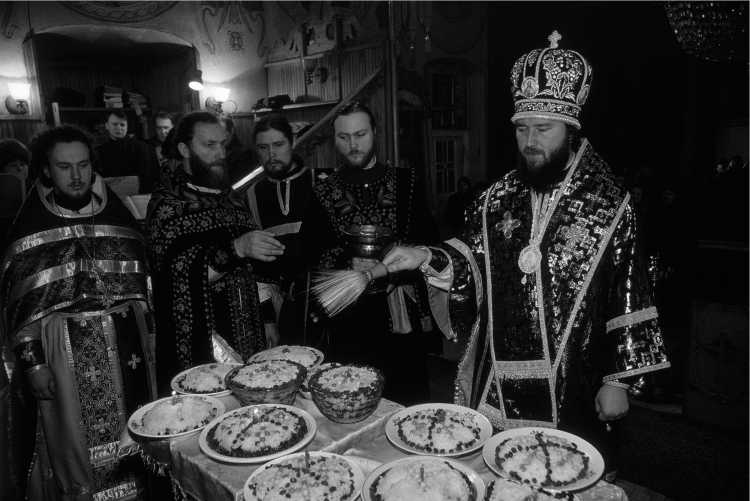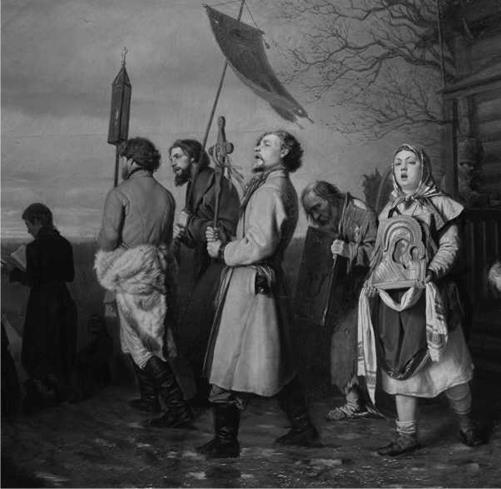Feasts
JOHN A. MCGUCKIN
Feasts or festivals are a regular occurrence in the liturgical calendar of the Orthodox Church. There are three main types of feast: firstly, the Dominical Festivals, which reflect significant events from the Lord’s ministry (such as the Nativity, the Presentation of Jesus in the Temple, the Baptism of Jesus, the Transfiguration, the Entry to Jerusalem, or Great Week Passion services); secondly, the festivals relating to the Theotokos (such as the Entrance of the Theotokos into the Temple; the Dormition, or the Protecting Veil); and third, the many feasts of the saints.
There is not one day of the year that does not have some form of special commemoration attached to it, or which does not feature the memorial day for one or many of the saints listed together. Mondays celebrate the Holy Angels; Tuesdays St. John the Forerunner; Wednesdays and Fridays the Holy Cross; Thursdays the Apostles; Saturdays All the Saints. Just as it is true that the Orthodox liturgy and prayer services are generally characterized by a distinct ascetical element (a certain sobriety of tone), it is equally the case that at a feast day or festival the church also knows how to rejoice. Often in the Orthodox world a special feastday is accompanied by many civic aspects of rejoicing. St. John’s day, in summer-time, for example, is accompanied by many celebrations in Greece, and jumping through fires. In Greece the transfiguration (August 6) is marked by the bringing in of the grape harvest, and the blessing of fruit in the church (in Russia, apples replaced grapes). Many local saint’s days (held around the churches dedicated to them) will witness a yearly fair at the festival, too. One cycle of festivals rotates entirely around the Paschal Mystery: Lent precedes it, Great Week synopsizes it, and Pentecost concludes it. Another cycle is static in the year: each year on January 6, for example, occurs the feast of the Baptism of the Lord, known as Theophany; each year on August 15 there occurs the Dormition of the Theotokos; each year on June 29 there occurs the feast of the Apostles Peter and Paul, and so on.
The theological character of the festival reflects the joy of the Paschal event: the hope of the believers that one day they also will be able to share the joys of heaven with the communion of elect saints who have already “entered into the joy of the Master” (Mt. 25.21). The feast of feasts, therefore, is Pascha itself, the liturgical memorial (anamnesis) of the resurrection of the Lord; and indeed every Eucharist of the Orthodox Church is a new Pascha made present; for all sacramental mysteries derive their force and grace from the paschal grace of Christ. The dividing up of the year with a series of festivals is a liturgical way of reflecting on how the Pascha is appropriated among his church today. The cycle of dominical feasts presents for joyful reflection one aspect of the saving ministry; so too the reflection on the life of the Virgin presents to the church an icon of the redeemed believer, theearthly woman who was lifted up to be “more honorable than the Cherubim” because of the grace of her Son. The lives and deeds of the saints (of so many different stations in life) are celebrated as icons for emulation and as testaments (martyria) of the power of Christ’s grace still operating in the world.

Plate 22 Russian bishop blessing the Kollyva memorial dishes at the liturgical commemoration of the dead. Olivier Martel/Corbis.

Plate 23 Vasily Grigorevich Perov (1834–1882), Easter Procession in the Country. Tretjakov Gallery/ AKG
The feasts themselves have special liturgical texts associated with them. Those for the major feasts can be found in the Festal Menaion; and each saint (as well as each type of saint – such as martyr, hierarch, Unmercenary healer, and so on) have particular Troparia and Kontakia associated with them, as found in the General Menaion. If a festival of a saint is being specially marked the church may gather for special Vespers and Orthros (Matins) followed by divine liturgy. The major Dominical and Marian festivals will always be marked in the monasteries, and usually have a special divine liturgy in the parishes.
SEE ALSO: Canonization; Dormition; Great Week; Menaion; Orthros (Matins); Theotokos, the Blessed Virgin; Vespers (Hesperinos)
REFERENCES AND SUGGESTED READINGS
Brotherhood of St. Seraphim (1994) The General Menaion. Wallasey, UK: Anargyroi Press.
Farmer, D. H. (1978) The Oxford Dictionary of Saints. Oxford: Clarendon Press.
Ware, K. and Mother Mary (eds.) (1969) The Festal Menaion. London: Faber and Faber.
